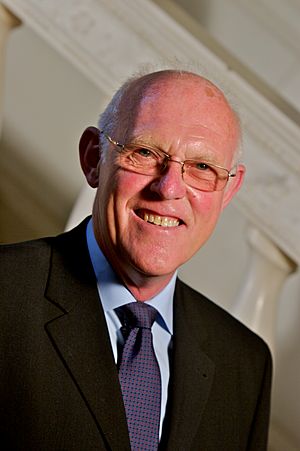Michael Brady (biomedical engineer) facts for kids
Quick facts for kids
Sir Michael Brady
FRS FMedSci FREng
|
|
|---|---|
 |
|
| Born |
John Michael Brady
30 April 1945 |
| Alma mater |
|
| Known for | Kadir–Brady saliency detector |
| Awards |
|
| Scientific career | |
| Fields |
|
| Institutions |
|
| Thesis | Just-non-cross varieties of groups (1970) |
| Doctoral advisor | László György Kovács |
| Doctoral students |
|
Sir John Michael Brady (born 30 April 1945) is a famous professor and scientist. He is an expert in computer vision and medical imaging. This means he teaches computers how to "see" and understand images, especially medical scans.
For many years, he was a professor at the University of Oxford. He has also worked at the famous Massachusetts Institute of Technology (MIT) in the United States. In 2015, he was given a special honor by the French Academy of Sciences for his important work.
Contents
Education and Early Life
Michael Brady was a very bright student. He studied mathematics at the University of Manchester in England. He earned both a Bachelor's and a Master's degree there.
After Manchester, he moved to Australia to continue his studies. He earned his PhD from the Australian National University in 1970. His research for his PhD was in a complex area of math called group theory.
A Career in Science and Technology
Sir Michael Brady has had a long and amazing career. He has worked on some of the most exciting ideas in computer science and robotics.
Teaching Computers to See
Brady is a world leader in image analysis. This is the science of teaching computers to understand what is in a picture. At MIT, he worked on ways for computers to recognize 2D and 3D shapes. This work was very important for the future of computer vision.
He also worked with other scientists to develop robotics. They published books and started conferences that are still important today.
Robots and Medical Discoveries at Oxford
In 1985, Brady moved to the University of Oxford. There, he started a new robotics laboratory. He and his team worked on building "mobile robots." These were robots that could move around on their own.
A big challenge was teaching the robots to see and avoid objects in their path. The team created systems that allowed a robot to swerve around an obstacle. If the path was too blocked, the robot could even plan a whole new route to its goal.
Later, Brady's work took a very personal turn. After a family member died from breast cancer, he decided to use his skills to fight the disease. For nearly 30 years, he has worked on new ways to analyze mammograms, which are X-ray pictures used to find breast cancer. He used math and physics to create better methods for spotting cancer early. This work led him to help start companies that create software for doctors.
Leading in Artificial Intelligence
Sir Michael Brady is also a leader in the world of Artificial Intelligence (AI). He is the Interim President of the Mohamed bin Zayed University of Artificial Intelligence (MBZUAI) in the United Arab Emirates. This is the world's first university that focuses only on AI.
His work has included creating special computer programs, or algorithms, that help with:
- Image segmentation: Breaking an image into different parts to understand it better.
- Image registration: Lining up two or more images of the same thing, even if they were taken at different times or from different angles.
- Feature detection: Teaching a computer to find important points or objects in a picture.
One of his famous inventions is the Kadir–Brady saliency detector. This is a tool that helps a computer figure out the most interesting or important parts of an image, much like our own eyes do.
Awards and Honors
Sir Michael Brady's work has earned him many awards. In 2004, he was knighted by the Queen for his services to engineering. This is why he is called "Sir" Michael Brady.
He was also elected a Fellow of the Royal Society in 1997. This is one of the highest honors a scientist in the UK can receive. The Royal Society recognized him for his incredible work in artificial intelligence and for using it to help guide robots. They said he was a pioneer in teaching computers to see like humans.
Some of his other major awards include:
- The Faraday Medal in 2000.
- The Millennium Medal from the Institute of Electrical and Electronics Engineers (IEEE) in 2000.
- Being named a Founding Fellow of the Association for the Advancement of Artificial Intelligence in 1990.
- Being elected a Fellow of the Academy of Medical Sciences in 2008.
He has also received honorary degrees from many universities around the world, recognizing his great contributions to science.

